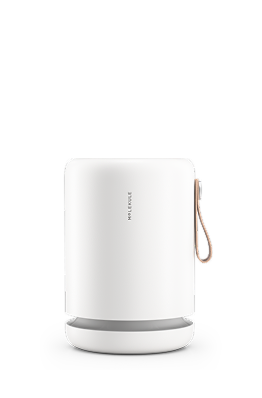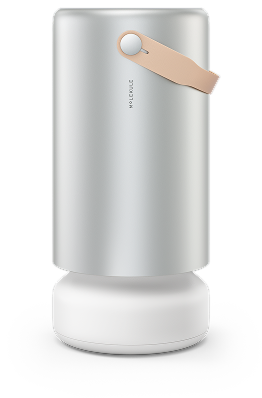Artists who work in their homes or in studios have unique indoor air quality problems to deal with. It might be the fumes caused by airborne chemicals emitted by paints or solvents, or it might be dust particles given off by ceramics, wood, plaster or other materials. There are many types of air purifiers to choose from that claim to solve these concerns. In this article, we shed light on what to look for in an air purifier depending on what art materials someone working in an art studio uses and what types of pollutants are of concern. By the end, you should be able to determine the best air purifier for many artistic practices.
Air quality concerns for artists
Art materials can give off several different types of pollutants, however the two main categories are airborne chemicals, called volatile organic compounds (VOCs), and particles. Removing both particles and VOCs from the air is crucial to maintaining a healthy working environment. In addition, it can be the key to creating successful pieces of art as we will learn from talking to several artists.
Paint fumes and other VOCs
Volatile organic compounds, or VOCs, are very useful for making art. Their organic nature softens and dissolves materials for workability, and their volatility causes them to quickly evaporate after use, leaving behind a hardened finished product. Paints, solvents, varnishes, resins, sculpting media, inks and dyes often utilize these properties of VOCs, but many of them are toxic if inhaled by humans. Toxic VOCs used in artistic materials can include formaldehyde, acetone, turpentine, toluene and many others. The EPA reports that VOC exposure can cause eye, nose and throat irritation; headaches, loss of coordination and nausea; and even damage to the liver, kidneys and the central nervous system. Plus, some VOCs are known carcinogens. A study from the Harvard School of Public Health found that VOCs from paints and other household products increased the risk of asthma, rhinitis, eczema and allergies in children (a problem for any artist with children who has a studio in their home).
We spoke to Kelly Barone, an artist who can be found at Twitter under @whimsybykelly. “Ventilation is always an issue, particularly with airbrush. I’ve given up oil painting entirely at this point due to the fumes.”
Ink painter Jonathan Wallraven told us, “Fumes can be from resins or, more commonly, the solvents involved in cleaning oil based inks from silk screens.”
Fine particle pollution from dry media
Some art-related pollution is in the form of particles. Sanding of wood, plaster, stone or filler material releases large amounts of dust into the air, and cutting materials can release dust as well. Particles released from the sanding or filing of plastic resins can be particularly toxic, and it is good practice to wet these materials prior to work with them to avoid dust floating in the air. Dry pastels and charcoal leave particles behind that are best “spanked” off outside, as blowing them into the air will contaminate a workspace. Even paints can become suspended in the air in particulate form, if they are aerosolized by an airbrush or spray can. Studies have found that an increase in particulate pollution (regardless of source) correlates to an increase in cardio-pulmonary health problems, although a connection to long-term health problems is less clear Pope et al>.
Consider the size of the art studio
Not only do artists have to deal with two different types of pollutants, they have other unique concerns as well. Some artists have limited space to work in, with only small areas of their home dedicated to their artistic endeavors. Or they may be working in a room with poor ventilation, such as a basement. This can lead to unsafe concentrations of pollutants while working.
On the other hand, some artists work in large areas with a lot of volume, like a university art studio, a converted warehouse space or a big attic. These spaces require an air purifier that can clean a sufficient volume of air relatively quickly. You can use the CADR number on an air purifier as a rough guide to its speed at cleaning air. However, keep in mind the CADR rating system only accounts for particles of smoke or dust in the air and cannot provide information about removing VOCs or other toxic gases. Reading plenty of reviews and understanding what kind of technology is inside can help you discover if an air purifier is capable of cleaning the air in your chosen workspace.
Dust and pet hair
One other air quality issue artists may want to consider is the problem of dust and other particles getting onto a wet project and getting stuck there, marring the final product. Ryan Hoerner, senior designer at Buffalo Big Print and creator of Cryptic Crayon told us, “Final finishes can be tricky when it comes to dust, especially having pets. I think it’s important to have a dedicated room that the pets are not allowed in to prevent any hairs or even dust kicked up from walking around. If an air filter was able to pull most of the small dust particles and pet hair out of the air I would most definitely consider getting one.”
So an air purifier that can remove dust, pet hair and other particles from the air will not only improve an artist’s health, but it will decrease the chance of dust or hair ruining a project.
Picking the best air purifier for an art studio
Surprisingly, none of the artists we spoke to currently use an air purifier. “I just wear a mask when possible, leave the doors open to air the place out, and work outside as much as possible,” Wallraven told us. “I’d need a relatively low cost system that could be moved from location to location.”
Barone wasn’t sure an air purifier would work in her large studio space. “It would need to be cost effective and useful in an 850 square ft space. Ideally it would do continual cleaning but the ability to just use it when necessary would also be helpful.”
Hoerner considers some method of dealing with dust and hair mandatory. “I would say most artists should consider getting one. I also work in a print shop/gallery where I scan artists’ work into digital files. When I am cleaning up the high resolution files I always see dust and particles that settled into their work and most of the time the artists request us to photoshop those out.”
Particulate pollution. HEPA filters and electrostatic air purifiers can effectively remove dust and other particles from the air. Air purifiers that use electrostatic technology have some drawbacks, however. They produce ozone as a side-effect, which is not only considered a lung irritant by the EPA but damages rubber and bleaches pigments and thus is generally not suitable for use near pieces of fine art. In addition, electrostatic purifiers cause particles to settle out of the air rather than trapping them in a filter. It is difficult to control exactly where electrostatically modified particles settle, so they may end up settling directly on your artwork. So for an artist’s purposes, a HEPA filter is preferable. HEPA filters are designed to trap 99.97 percent of all particles that are 0.3 microns in diameter. They are proven to be effective, but need to be replaced regularly, as they eventually become clogged.
VOCs. VOCs can be more difficult to deal with than particles. The first line of defense against fumes from paints and solvents is ventilation. Always use such substances as directed by the manufacturer in a well-ventilated space. A box fan directed to blow air out a window is an excellent solution. Wearing a respirator might be a good idea, depending on what substances you are working with. Carbon or charcoal filters can be effective at removing VOCs from the air. However, they are often designed to remove particular substances from the air, like the toxins from tobacco smoke, so they might not be effective against the chemicals in your paints and solvents. Also, since they don’t actually destroy VOCs, charcoal filters get “filled up” and lose their effectiveness, requiring frequent replacement or eventually reintroducing VOCs into the room they are supposed to be purifying. The most effective carbon filters have a large weight of carbon, at least fifteen pounds, which will soak up VOCs but can be heavy to move around and expensive to replace.
An air purifier technology that can remove particles and VOCs from the air, while also being cost-effective and portable, would be ideal for the artists we spoke with. The Molekule air purifier is capable of both particle filtration and removal of VOCs from the air. It also comes equipped with a handle for ease of portability from workspace to workspace. Molekule uses PECO technology in addition to carbon so it both captures and destroys VOCs.
It is important to keep the air in your artist studio free of pollutants that could affect your health and the quality of your projects. It is best to think about the most likely pollutants in your studio air, talk to other artists about their solutions, do your research, and then choose an appropriate solution.




